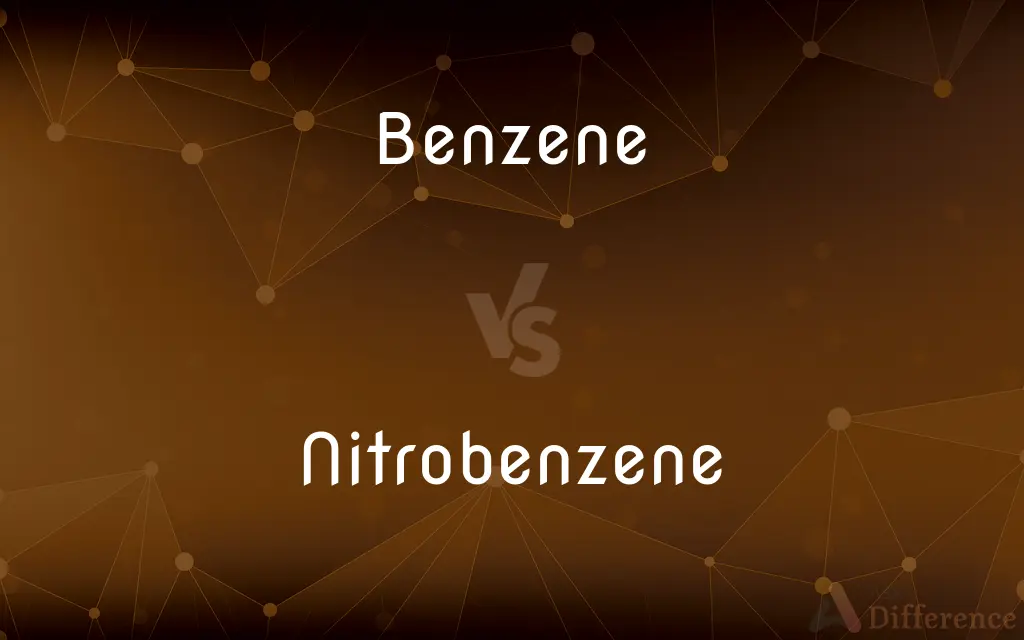Benzene vs. Nitrobenzene — What's the Difference?
By Urooj Arif & Maham Liaqat — Updated on April 5, 2024
Benzene is a simple aromatic hydrocarbon with a ring structure, while nitrobenzene is benzene with a nitro group (-NO2) attached, altering its chemical and physical properties.

Difference Between Benzene and Nitrobenzene
Table of Contents
ADVERTISEMENT
Key Differences
Benzene is a basic organic chemical compound characterized by a ring of six carbon atoms bonded to hydrogen atoms, known for its role in forming more complex chemical substances. It is a colorless and highly flammable liquid with a sweet smell, widely used in the manufacture of plastics, resins, synthetic fibers, rubber lubricants, dyes, detergents, drugs, and pesticides. On the other hand, nitrobenzene is derived from benzene through the substitution of one hydrogen atom with a nitro group (-NO2), giving it different chemical behaviors and applications.
The presence of the nitro group in nitrobenzene significantly alters its physical and chemical properties compared to benzene. For example, nitrobenzene is less flammable than benzene and has a higher boiling point. While benzene is known for its carcinogenic properties and toxicity, adding a nitro group makes nitrobenzene even more toxic.
Benzene's applications range from serving as a solvent in many chemical and industrial processes to being a fundamental building block for manufacturing polymers and other complex molecules. Conversely, nitrobenzene's primary use is in the synthesis of aniline, a key ingredient in the manufacture of various industrial chemicals, including polyurethane foam, agricultural chemicals, synthetic dyes, antioxidants, and pharmaceuticals.
Despite their different applications and properties, both benzene and nitrobenzene pose significant health risks. Exposure to benzene can lead to blood disorders, including leukemia, whereas nitrobenzene exposure can cause methemoglobinemia, a condition where the blood loses its ability to carry oxygen efficiently. This underscores the importance of handling both chemicals with appropriate safety measures.
Comparison Chart
Chemical Structure
C6H6 (six carbon ring with H atoms)
C6H5NO2 (benzene ring with a NO2 group)
ADVERTISEMENT
Physical Appearance
Colorless, highly flammable liquid
Pale yellow, oily liquid
Odor
Sweet, aromatic
Almond-like
Boiling Point
80.1 °C
210.9 °C
Primary Uses
Solvent, production of polymers and chemicals
Production of aniline, synthetic dyes
Flammability
Highly flammable
Less flammable than benzene
Industrial Application
Plastics, synthetic fibers, lubricants
Dyes, drugs, polyurethane foam
Compare with Definitions
Benzene
Colorless liquid with a sweet, aromatic smell.
The characteristic smell of benzene can be detected in some chemical labs.
Nitrobenzene
Benzene derivative with a nitro group attached, altering its properties.
Nitrobenzene is produced by nitrating benzene with nitric acid.
Benzene
A basic aromatic hydrocarbon with a hexagonal ring structure.
Benzene is used as a solvent in the pharmaceutical industry.
Nitrobenzene
Primarily used to manufacture aniline.
Aniline, derived from nitrobenzene, is crucial for producing synthetic dyes.
Benzene
Highly flammable, used in manufacturing a wide range of chemicals.
Benzene is a key ingredient in the production of styrene for making polystyrene plastics.
Nitrobenzene
Pale yellow, oily liquid with an almond-like odor.
The distinct smell of nitrobenzene can be recognized in certain industrial settings.
Benzene
Solvent in various chemical reactions.
Benzene is often used to dissolve other chemicals during synthesis processes.
Nitrobenzene
Less flammable than benzene, with a higher boiling point.
Nitrobenzene's physical properties make it safer to handle in certain conditions.
Benzene
Known carcinogen affecting blood production.
Long-term exposure to benzene can increase the risk of leukemia.
Nitrobenzene
Nitrobenzene is an organic compound with the chemical formula C6H5NO2. It is a water-insoluble pale yellow oil with an almond-like odor.
Benzene
Benzene is an organic chemical compound with the molecular formula C6H6. The benzene molecule is composed of six carbon atoms joined in a planar ring with one hydrogen atom attached to each.
Nitrobenzene
A colorless or yellowish poisonous oily liquid, C6H5NO2, having the odor of almonds and used in the manufacture of aniline, insulating compounds, and polishes.
Benzene
A colorless, flammable, toxic, liquid aromatic hydrocarbon, C6H6, derived from petroleum and used in or to manufacture a wide variety of chemical products, including DDT, detergents, insecticides, and motor fuels. Also called benzol.
Nitrobenzene
(organic compound) A nitro derivative of benzene, C6H5NO2, prepared by reacting benzene with a mixture of nitric and sulphuric acids; any of a series of such compounds having two or more nitro groups
Benzene
(organic compound) An aromatic hydrocarbon of formula C6H6 whose structure consists of a ring of alternate single and double bonds.
Nitrobenzene
A yellow aromatic liquid (C6H5.NO2), produced by the action of nitric acid on benzene, and called from its odor imitation oil of bitter almonds, or essence of mirbane. It is used in perfumery, and is manufactured in large quantities in the preparation of aniline. Fornerly called also nitrobenzol.
Benzene
Sometimes used in place of the phenyl group.
Nitrobenzene
A poisonous oily water-soluble liquid used as a solvent and in the manufacture of aniline
Benzene
A volatile, very inflammable liquid, C6H6, contained in the naphtha produced by the destructive distillation of coal, from which it is separated by fractional distillation. The name is sometimes applied also to the impure commercial product or benzole, and also, but rarely, to a similar mixed product of petroleum.
Benzene
A colorless liquid hydrocarbon; highly inflammable; carcinogenic; the simplest of the aromatic compounds
Common Curiosities
Can benzene cause cancer?
Yes, benzene is a known carcinogen that has been linked to blood disorders, including leukemia, with long-term exposure.
What is benzene used for?
Benzene is used as a precursor in the manufacture of various chemicals, including plastics, resins, synthetic fibers, and as a solvent in chemical reactions.
Why is nitrobenzene toxic?
Nitrobenzene is toxic because it can induce methemoglobinemia, a condition that reduces the oxygen-carrying capacity.
What precautions should be taken when handling these chemicals?
When handling benzene or nitrobenzene, use appropriate personal protective equipment, work in well-ventilated areas, and follow all safety protocols to minimize exposure and risk of inhalation or skin contact.
What is the role of aniline in industry, and how is it related to nitrobenzene?
Aniline is a key chemical in the production of synthetic dyes, pharmaceuticals, and polyurethane foam. It is synthesized directly from nitrobenzene, making the latter an essential precursor in aniline production.
How is nitrobenzene made?
Nitrobenzene is made by the nitration of benzene, involving the substitution of a hydrogen atom with a nitro group (-NO2) using nitric acid.
What are the main differences between benzene and nitrobenzene?
The main differences lie in their chemical structure, physical properties, and uses. Nitrobenzene, which contains a nitro group, is more toxic and used mainly in the production of aniline, while benzene is a fundamental organic chemical used in a broader range of industries.
Is nitrobenzene more flammable than benzene?
No, nitrobenzene is less flammable than benzene, partly due to its higher boiling point and the presence of the nitro group.
How do environmental regulations affect the use of benzene and nitrobenzene?
Environmental regulations tightly control the use, disposal, and emissions of both benzene and nitrobenzene due to their toxicity and potential to harm human health and the environment.
Can both benzene and nitrobenzene be found in consumer products?
While direct use in consumer products is limited due to their toxicity, they are used in the manufacture of a wide range of goods, from plastics to pharmaceuticals.
Share Your Discovery

Previous Comparison
Farce vs. Slapstick
Next Comparison
Cloister vs. PeristyleAuthor Spotlight
Written by
Urooj ArifUrooj is a skilled content writer at Ask Difference, known for her exceptional ability to simplify complex topics into engaging and informative content. With a passion for research and a flair for clear, concise writing, she consistently delivers articles that resonate with our diverse audience.
Co-written by
Maham Liaqat













































